Reviewed by Mila PereraSep 26 2022
Researchers at the University of Oxford examined the advantages of employing soft robotic systems and humanoid musculoskeletal robots as bioreactor platforms to create clinically effective tendon constructions.

Image Credit: Shutterstock.com/goodluz
The new review paper, published on September 15th, 2022, in the journal Cyborg and Bionic Systems, summarizes current tendon tissue engineering trends and explains how conventional bioreactors are incapable of providing physiologically relevant mechanical stimulation, given that they heavily rely on uniaxial tensile stages.
To close this translational gap, the research presents soft robotic systems and musculoskeletal humanoid robots as platforms for providing mechanical stimulation that is physiologically relevant.
The market for tendon restoration in the US is around 1.5 billion USD, and tendon and soft tissue injuries are a major social and economic issue. Over 40% of rotator cuff repairs fail after surgery due to the high revision rates associated with tendon repair procedures.
Producing engineered tendon grafts for clinical use could provide a solution. Typical tendon bioreactors provide uniaxial tensile stimulation. The lack of systems that recapitulate in vivo tendon loading creates a major translational gap.
The human body provides tendons with three-dimensional mechanical stress in the form of tension, compression, torsion, and shear. Current research suggests that healthy native tendon tissue requires multiple types and directions of stress. Advanced robotic systems such as musculoskeletal humanoids and soft robotics promising platforms that may be able to mimic in vivo tendon loading.
Iain Sander, Study Author and Researcher, Soft Tissue Engineering Research Group, University of Oxford
Initial uses for musculoskeletal humanoid robots included crash test dummies, prosthetics, and athletic enhancement. They attempt to mimic human anatomy with similar body proportions, skeletal structures, muscle arrangements, and joint structures.
Myorobotic actuators resembling human neuromuscular tissue are used in tendon-driven systems by musculoskeletal humanoids like Roboy and Kenshiro.
Myorobotic units are composed of a brushless DC motor that produces tension similar to human muscles, attachment cables that simulate tendons, and a motor driver board with a spring encoder that simulates the neurologic system by sensing variables like tension, compression, muscle length, and temperature.
Potential benefits of musculoskeletal humanoids include the capacity for multiaxial loading, the potential for loading taking into account human movement patterns, and the availability of loading magnitudes equal to in vivo forces.
One recent study showed that it is possible to construct tendons using human tissue grown on a musculoskeletal humanoid robot.
Biohybrid soft robotics aims to create bio-inspired, compliant robotic systems that enable flexible, adaptable interactions with uncertain settings. Numerous modalities, such as temperature, pneumatic and hydraulic pressure, and light, are used to activate these robotic devices.
They are constructed from soft substances like hydrogels, rubber, and human musculoskeletal tissue. These methods have been deployed in vivo in a porcine model and are currently used to stimulate smooth muscle tissue constructs mechanically.
These systems are appealing for tendon tissue engineering given that their flexibility allows them to wrap around anatomic structures, emulating the native tendon.
They are also capable of providing multiaxial actuation, and several techniques used in soft robotics coincide with contemporary tendon tissue engineering practices.
The team intends to use advanced robotic systems as platforms that will provide physiologically relevant mechanical stimulus to tendon grafts before clinical use.
As more sophisticated robotic systems are used, there are a variety of difficulties to take into account. First, it will be crucial for future tests to contrast the technologies in this evaluation with traditional bioreactors.
The development of multiaxial loading systems will require the development of techniques for strain measurement in three dimensions. Finally, sophisticated robotic systems will need to be more affordable and available for widespread adoption.
An increasing number of research groups are showing that it is feasible to use advanced robotics in combination with living cells and tissues for tissue engineering and bioactuation applications. We are now at an exciting stage where we can explore the different possibilities of incorporating these technologies in tendon tissue engineering and examine whether they can really help improve the quality of engineered tendon grafts.
Pierre-Alexis Mouthuy, Study Senior Author and Associate Professor, Nuffield Department of Orthopedics, Rheumatology and Musculoskeletal Sciences, University of Oxford
These technologies can enhance individual quality of life by reducing pain and the likelihood of tendon repair failure. They can also benefit healthcare systems by lowering the need for revision procedures and the economy by raising workplace productivity and cutting medical expenses.
Iain Sander, Nicole Dvorak, Julie Stebbins, Andrew J. Carr, and Pierre-Alexis Mouthuy are the study's authors.
The Engineering and Physical Sciences Research Council of the United Kingdom (project number: 17 P/S003509/1) and the Rhodes Trust provided funding for this work.
Journal Reference
Sander, I. L., et al. (2022) Advanced Robotics to Address the Translational Gap in Tendon Engineering. Cyborg and Bionic Systems. doi:10.34133/2022/9842169.